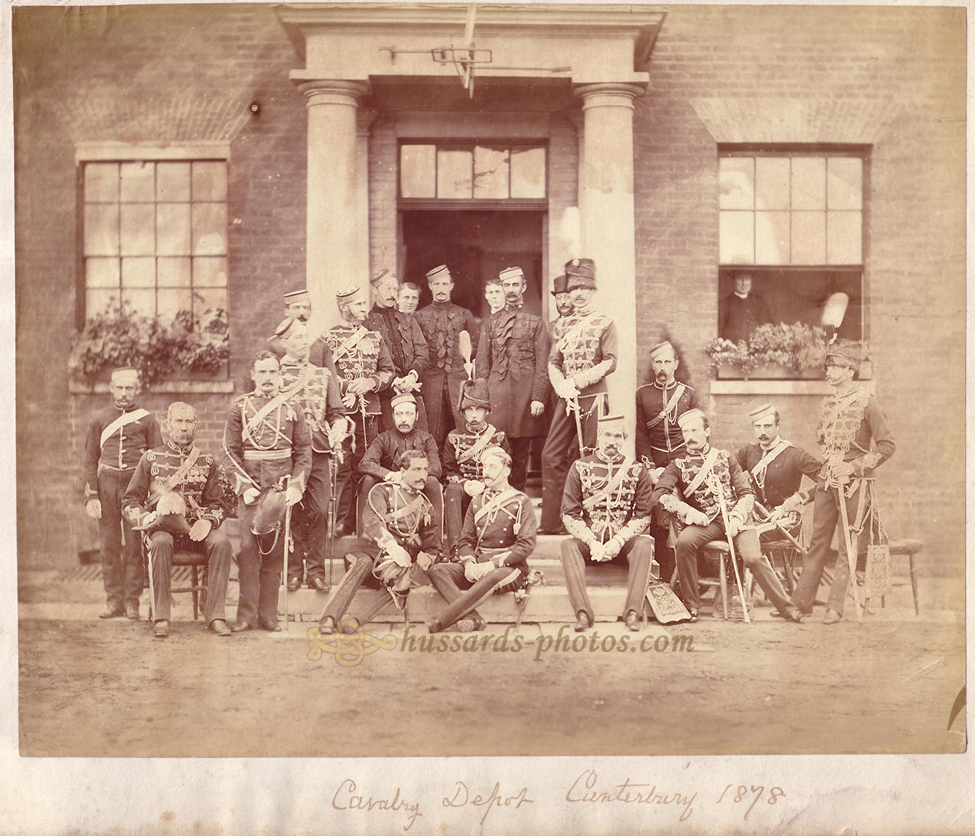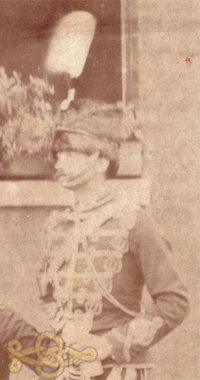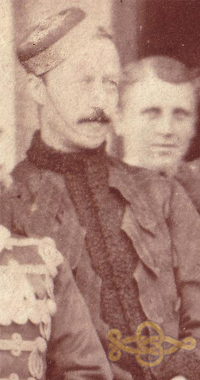|
Mounted
photograph
Officers
at the Cavalry Depôt in Canterbury - 1878 |
| The Cavalry Depôt
comprised a permanent staff, and officers detached from the
various
Cavalry Regiments serving overseas.
This photograph was taken in 1878, just
prior to the 2nd Afghan War where some of these officers would
undoubtedly serve, and definitely bring from the Depôt much
needed drafts to reinforce their regiments.
Reading the service of these gentlemen
provides a fascinating insight into some of the most famous pages
of History of British Cavalry.
|
|
|
Staff of the
Cavalry Depôt in 1878
|
Commandant.............................................................
Superintendent Riding Dept.................................
Adjutant....................................................................
Paymaster..................................................................
Riding Master..........................................................
Quarter Master........................................................
Instructor of Musketry..........................................
|
Colonel Conyer Towers,
C.B. (up to 19 June 1878)
Brevet-Colonel Edward Napier, late 6 Dr. Gds. (from 19 June
1878)
Major W. Blenkisop, h.p.,
late 3 Dr. Gds.
Capt. Robert Spencer
Liddell, 10th Hussars
Charles Boyse Roche
John Atkins Pickworth
Henry Woods
Lieut. S.J. Lea, 3d
Hussars (up to 12 November 1878 - dated October 1st)
Lieut. the Hon. Eustace Vesey, 9th Lancers (from 12
November 1878 - dated Oct. 1st)
|
|
|
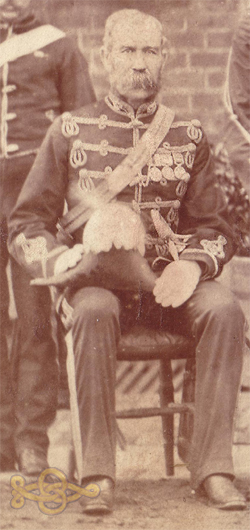
|
Quarter Master Henry
Woods
Quarter Master Woods can easily be
recognized thanks to his cocked hat with white feather.
Henry Woods first served in the 3rd Light
Dragoons as a trooper, then a Non Commissioned Officer ; Hart's
List details his War Services :
"Quarter Master Woods served the campaign
of 1842 in Affghanistan (Medal), including the forcing of
the Khyber Pass. Served the Sutlej campaign of 1845-46, including
the battles of Moodkee, Ferozeshah, and Sobraon (Medal and two
Clasps). Also the Punjaub campaign of 1848-49,including the affair
at Ramnuggur, passage of the Chenah, action at Sadoolapore, and
battles of Chillianwallah and Goojerat (Medal with two Clasps)."
Regimental Serjeant-Major Woods was
gazetted Quartermaster in the 3rd Light Dragoons on August 23rd,
1861.
He was appointed to the Cavalry Depôt as Quartermaster on June
22d, 1867, then transferred to the 18th Hussars (still as
Quartermaster) on June 22d, 1870.
He was reappointed to the Cavarly Depôt
when it was reorganized, on June 28th, 1871.
The London Gazette would publish on
August 15th, 1882 :
"Cavalry Depôt, Quartermaster, with the honorary and
relative rank of Captain, Henry Woods to be placed on retired pay,
with the honorary rank of Major. Dated 22nd August, 1882."
|
|

|
Riding
Master John Atkins Pickworth
The Riding Master can be recognized
thanks to his rank (he looks a bit of an experienced gentleman for
a junior rank), and the Medals he is sporting, indicating a fair
bit of service as well. As a matter of fact, Hart's List details
his War Services :
"Riding Master Pickworth served the Eastern
campaign of 1854-55 with the 8th Hussars,including the
reconnaissance to Silistria, Battles of Alma, Balaklava, Inkerman,
and the Tchernaya, affairs of Bulganak and M'Kenzie's Farm, siege
and fall of Sebastopol (Medal with four Clasps, French War Medal,
and Turkish Medal). Served in the Indian campaigns of 1858-59 and
was present at the capture of Kotah, reoccupation of
Chundaree,battle of Kota ke Serai, capture of Gwalior, and action
of Boordah (Medal with Clasp)."
He enlisted in the 8th Hussars c. 1840,
with the Regimental Number 840.
Sergeant Pickworth would embark to the Crimea in the H.T.'Medora'
on April 27th 1854. He was to feature in the famous "Charge
of the Light Brigade", one of the "Gallant Six
Hundred" immortalized by Lord Tennyson.
He is mentioned in an account of the
Charge, published in the "History of the VIII King's Royal
Irish Hussars" (by the Rev. Robert H. Murray) :
The Charge of the
British Cavalry at Balaclava
By one who was in it
"(...) I saw,
as (the Colonel) passed in front of us, that all at once his face
expressed the greatest surprise and astonishment, and even anger,
and, walking on, he broke out with, "What's this ?" what's
this ?-one, two, four, six, seven men smoking !-swords drawn,
and seven men smoking !-why, the thing is inconceivable !
Sergeant-Sergeant Pickworh," he calls out.
And the truth is-for I was one of them- the truth is, we were
warming our noses each with a short black pipe, and thinking no harm
of the matter : and, by the bye, I lost mine, for I passed it
quietly to poor Jack Miller in my rear, who went in with us into the
charge, and was missed- so that I never got back my pipe. "I
never heard of such a thing," the Colonel said, "and no
regiment except an 'Irish' regiment would be guilty of it. Sergeant,
advance and take these men's names," and leaving the sergeant
to find us out, though he couldn't discover any, the Colonel passed
on, and halted again. All this time I heard strange dull noises
thickening in the air. it might not be quite according to regulation
to be smoking, sword in hand, when the charge might be sounded any
moment. Our Colonel was a religious man too, which helped him to his
nickname, I dare say,and he imagined perhaps we ought to have been
thinking of our souls instead of tobacco pouches and inch of clay.
(...)"
Sergeant Pickworth is
also mentioned in another account of the charge :
"Robert Briggs had his
horse shot from underneath him in the charge, but escaped unwounded
by grabbing a horse caught by Sgt Seth Bond of the same Regiment who
had stopped it for a Sgt Pickworth of the 8th Hussars, who called
for his fellow Sgt to stop the free horse for him. Unfortunately it
was 'nabbed' by Briggs who was intent on having it ,much to the
annoyance of Pickworth who said " Ah, well, I suppose all is
fair in war, so let me have hold of each of your stirrups, and Ill
run, the sooner we get out of this the better". They then
rushed off with the gallant Sgt running in between their horses, to
safety."
|
He was promoted to Troop
Sergeant-Major on the next day, October 26th, 1854.
The 8th Hussars
would remain in the Crimea until April 1856, to come back home,
before being sent to India in September 1857, at the outbreak of
the Mutiny.
Pickworth was appointed Regimental
Sergeant-Major on October 16th, 1857, and appointed Riding-Master
on August 31st, 1858.
He came back from India with the 8th Hussars on board the St.
Lawrence East Indiaman, leaving Calcutta on the 13th of January
1864, calling at the Cape of Good Hope on the 1st of March, at St.
Helena on the 12th of March and reaching Portmouth on Tuesday
afternoon, April 26th, 1864.
He was appointed to the Cavalry Depôt on April 28th, 1875.
He would retire on half-pay, with the honorary rank of Captain, on
April 24th, 1879, being installed as a Military Knight of Windsor
on the same day.
He was a Member of the 1879 Balaclava Commemoration Society.
He was married to Margaret, who held an account by the 'London
and Westminster Bank' ; their adress can be traced through the
yearly statements published in February in the London Gazette :
1870 : Dundalk, Ireland
1871-72 : Island-bridge Barracks, Dublin
1874-76 : 8th Hussars, Longford Barracks
1877-79: Care of J.A. Pickworth, Cavalry Depôt, Canterbury
1880 : 1, Salisbury Tower, The Castle, Windsor
He was gazetted on retired pay on
September 30th, 1881 (dated July 1st).
On January 4th, 1892, he attended the funeral of Prince Victor of
Hohenlohe (Governor and Constable of Windsor Castle), among a
deputation from the Military Knights of Windsor, posted near the
church door by the Queen's command.
On May 24th, 1895, he was invited to attend Verdi's Opera Il
Trovatore, by the Royal Opera Company, performed at the Waterloo
Chambers of Windsor Castle for the Royal Household.
His wife Margaret died "after a short illness" on
the 10th of Februray, 1896, "at No.18, Lower Ward, Windsor
Castle".
His obituary was published in "The
Times" on February 23d, 1901 :
"Captain John Atkins Pickworth, a Military
Knight of Windsor, formerly of the 8th Hussars and Cavalry depôt
Staff, died early yesterday morning at his residence in the Lower
Ward, Windsor Castle. Captain Pickworth was born on March 18,
1824, and was consequently nearly 77 years of age. He joined the
Army on February 18, 1840, and served in the 8th Hussars for
upwards of 35 years. He served in the Crimean campaign, including
the Earl of Cardigan's reconnaissance of Silistria, and in the
indian Mutiny, and was in 12 engagements-Bulganac, Alma,
McKenzie's Farm, Balaclava, Inkerman, Tchernaya, and Sevastopol,
in the Crimea, and the capture of Kotah, the reoccupation of
Chundaree, the battle of Kota-keserai, the capture of Gwalior, and
the action of Boordah, in India. He rode in the famous charge of
the Six Hundred at Balaclava, and was one of a squadron that
charged into and through the enemy's camp at Kota-keserai, in
India, in which several guns were captured.he received four medals
and five clasps, was recommended for the Victoria Cross, and his
name was twice mentioned in the records of his regiment for having
"distinguished himself by his steadiness and coolness in
keeping the men together and the squadron unbroken" - after
the death of the officers in the Light Brigade charge at Balaklava
; andduring the Indian Mutiny, at Kota-keserai, when, owing to the
death of his officer, he succeeded to thecommand of a troop
covering the retreat, and was recommended for and awarded the
commission vacant by the death of Lieutenant Reilly, who was
killed in action. Captain Pickworth was selected by the Duke of
Cambridge, then Commander-in-Chief, for the Cavalry Depôt Staff
on May 12, 1875, and was appointed by the late Queen Victoria a
Military Knight of Windsor on April 24, 1879, after over 39 years
of continuous service."
|
|
|
The
Cavalry Regiments at the Depôt in 1878
|
|
The following Cavalry Regiments were serving
overseas in 1878 :
|
- 6th Dragoon Guards.............................
- 3rd Hussars.........................................
- 4th Hussars..........................................
- 9th Lancers..........................................
- 10th Hussars........................................
- 12th Lancers........................................
- 13th Hussars........................................
- 14th Hussars........................................
- 15th Hussars........................................
|
At sea for India in December 1877
In India since 1868 ; they would come back to England in 1879
In India since 1867 ; would sail from Bombay on December 6th 1878
In India from 1875 to 1885
In India since 1873 ; would come back in 1884
In India from 1877 to 1887
In India ; would remain at sea until 1885
In India from 1876 to 1886
In India since 1868 ; would come back in 1882
|
|
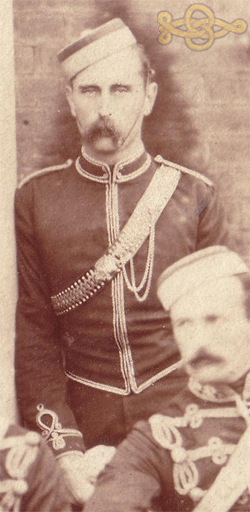
|
Captain Robert Collinson
d'Esterre Spottiswoode
10th P.W.O. Hussars
His Regiment can easily be ascertained
thanks to :
- His regimental pattern stable jacket (no olivets, and specific
cuff embroidery)
- The specific pouch belt so characteristic of the 10th Hussars.
His Obituray was published in The Times on
March 23d, 1936 :
"Colonel R.C. d'E. Spottiswoode
Last Combatant Survivor of the Mutiny ?
Colonel R.C.D'E.Spottiswoode, who died at his home at Glenmire, Co.
Cork, on Saturday, at the age of 94, was in all probability the last
combatant survivor of the Indian Mutiny. He kept his vigour of mind
to the end, and only last year brought out a discursive volume of
"Reminiscences" for private circulation.
Robert Collinson d'Esterre Spottiswoode was born in India on
Christmas Eve, 1841, to Major-General Arthur Cole Spottiswoode,
Bengal Army, and Jessy Eliza Loveday. His book shows that the son of
an officer of the East india Company's forces in the early Victorian
years led almost the life of afoundling, not seeing his parents for
years on end. He was educated at Edinburgh Academy and Merchiston
Castle, Edinburgh. Soon after he had been moved to London, to the
Clapham Grammar School, in order to be near his parents when his
father was on leave, he was "whisked away" at 16 to be one
of the many lads sent to India as cadets during the Mutiny. He was
given a cornetcy in the 3rd Bengal European Cavalry. he saw some
fighting, for in May, 1858, while with a detachment of recruits
proceeding to Allahabad to join the regiment, he was in an
engagement with the mutineers at Sasseram, near Benares. Afterwards
he served under Lord Clyde. As he said in a letter published in The
Times of May 11, 1934, it never occurred to him to claim the Mutiny
Medal. "The presence of so many warriors who had served at the
siege of Delhi and the relief of Lucknow so impressed me that I kept
my mouth shut on the subject of a medal."
He was
promoted lieutenant, and a little later the East India Company's
troops were amalgamated with the forces of the Crown.
|
In 1861 the 21st Light
Dragoons was formed out of volunteers from his old regiment, which
was disbanded, and he transferred to the new corps, which became
Hussars in 1862, was converted into a Lancer regiment in 1897, and
is now amalgamated with the 17th Lancers. He was promoted captain in
April, 1870, and in February, 1874, exchanged into the 10th Hussars,
which were then in India. With the 10th Hussars he served in the
second Afghan War during 1879,and it was his squadron which met with
disaster in fording the Kabul river at night, an episode well known
as the theme of a Kipling ballad. he got his majority in July, 1881,
and in April, 1882, was appointed A.D.C. to Lieutenant-General
Charles Cureton, commanding at Oudh.
Selected for special service with Graham's force which was assembled
to cover the construction of the railway to Berber, he arrived at
Suakin in February, 1885, after the fall of Khartoum, and from March
to June acted as D.A.A. and Q.M.G. here he came under the favourable
notice of Wolseley, received the Brevet of lieutenant-colonel, and
was mentioned in dispatches. After 16 months' residence in Russia
inorder to qualify as an interpreter he reached the substantive rank
of lieutenant-colonel in September, 1887, on appointment as
D.A.Q.M.G. and D.A.A.G., Cork District, and was promoted colonel in
October, 1889. He retired from the Army on an Indian pension in
September, 1890.
Though he enjoyed his Indian service and was keen on polo, rackets,
and cricket, he suggests in his reminiscences that his too early
apprenticeship to the Army led to late, rather than precocious,
maturity ; and he felt that he only began to live when sent to
Ireland. He followed hounds until he was 74, and up to his last
illness he had a cold bath every morning at 8 o'clock. Coming to the
conclusion that tobacco was unhealthy he gave up smoking 20 years
ago. He attributed his robust health to his Huguenot descent.
Colonel Spottiswoode married in 1885 Anne Elizabeth Turnbull, but
had no children."
Captain Spottiswoode had come back
from India on board the Jumna, reaching Portsmourth on January 18th,
1876.
He sailed back for Bombay on November 1st, 1878 on board the Indian
troopship Malabar, with a draft of 71 men of the 10th Hussars.
This is a most interesting information, as it allows to narrow the
timeframe in which this photograph was taken.
|
|
|
